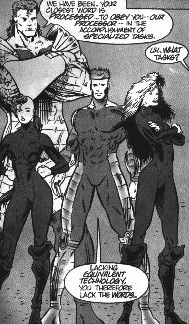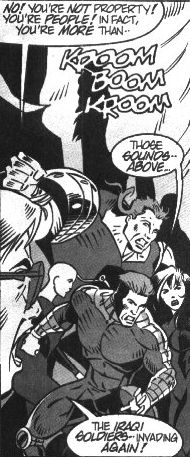
 Xenobrood
(DC)
Xenobrood
(DC)A 7-issue miniseries (#0-#6)
by Doug Moench, Tomm Coker/Chris Hunter, Keith Aiken/Dennis Cramer/John Lowe
Rating:
This series was printed in color, but I sold my copies before I got access to a color scanner. Hence, the b&w art samples.
![]() Xenobrood was launched the month after Zero Hour, but really had nothing
to do with that event, not even a hokey foreshadowing in the Zero Hour
miniseries. In fact, except for an appearance by Superman, it didn't
have anything to do with the DCU. Whether these points are good or bad
is left up to the reader. {grin}
Xenobrood was launched the month after Zero Hour, but really had nothing
to do with that event, not even a hokey foreshadowing in the Zero Hour
miniseries. In fact, except for an appearance by Superman, it didn't
have anything to do with the DCU. Whether these points are good or bad
is left up to the reader. {grin}
![]() It didn't look as interesting as Starman or
Primal Force, but not as
{despairing sigh}-inducing as Fate or
Manhunter, so I decided to give it
a chance. Plus, it was only seven issues: no real commitment.
It didn't look as interesting as Starman or
Primal Force, but not as
{despairing sigh}-inducing as Fate or
Manhunter, so I decided to give it
a chance. Plus, it was only seven issues: no real commitment.

![]() I'll get the art out of the way first, because it's the least impressive
part of the book. At first I was disappointed by newcomer Coker's pencils (to the right),
which gave odd proportions and shapes to body parts such as legs, breasts,
and mouths. Then he and the first two inkers were replaced (after three
issues), and things got worse. Hunter (to the left) apparently left out most of the
backgrounds, and Lowe seems to have inked each page in 15 minutes. I've
never seen anything else by Hunter, but I've seen Lowe do far better on
early Blood Syndicate and Firearm. [See also his later work on
DC's Eradicator miniseries.] Given its lack of
any real attachment to Zero Hour, I wish they'd postponed this book to do the art right.
I'll get the art out of the way first, because it's the least impressive
part of the book. At first I was disappointed by newcomer Coker's pencils (to the right),
which gave odd proportions and shapes to body parts such as legs, breasts,
and mouths. Then he and the first two inkers were replaced (after three
issues), and things got worse. Hunter (to the left) apparently left out most of the
backgrounds, and Lowe seems to have inked each page in 15 minutes. I've
never seen anything else by Hunter, but I've seen Lowe do far better on
early Blood Syndicate and Firearm. [See also his later work on
DC's Eradicator miniseries.] Given its lack of
any real attachment to Zero Hour, I wish they'd postponed this book to do the art right.
![]() But enough harping about the bad art... on to the story, which has more
to recommend it.
But enough harping about the bad art... on to the story, which has more
to recommend it.
![]() It's about archaeologist Zecharia Leight, who discovers the plot-equivalent
of a magic lamp, which brings forth a quartet of superbeings ready to obey
his every command. They include: a Handsome Male Leader, a Big Guy, a
Large-Breasted Woman, and a Bald Large-Breasted Woman. Each has a
different gimmick power (e.g. energy bolts, teleportation) and bottom-of-
the-barrel codename (Zapatak, Blip, Thrasher, and Astra).
It's about archaeologist Zecharia Leight, who discovers the plot-equivalent
of a magic lamp, which brings forth a quartet of superbeings ready to obey
his every command. They include: a Handsome Male Leader, a Big Guy, a
Large-Breasted Woman, and a Bald Large-Breasted Woman. Each has a
different gimmick power (e.g. energy bolts, teleportation) and bottom-of-
the-barrel codename (Zapatak, Blip, Thrasher, and Astra).
![]() Hmmm, I was going to talk about the better aspects, wasn't I?
Hmmm, I was going to talk about the better aspects, wasn't I?
![]() The story begins with Leight discussing the origins of modern homo sapiens,
and the mystery of early Sumerian culture. Pretty intellectual stuff for
a funnybook, eh? It then sets up a fresh mystery, with the discovery of
a seemingly modern artifact among ancient Sumerian ruins... and the ninjas
who come after Leight when they learn of it, only to vanish in a flash of
blue light. Then Leight figures out that the artifact contains the
"ingredients" and "recipe" to create these four beings: the Xenobrood,
who greet him saying, "We are now prepared to obey your commands."
The story begins with Leight discussing the origins of modern homo sapiens,
and the mystery of early Sumerian culture. Pretty intellectual stuff for
a funnybook, eh? It then sets up a fresh mystery, with the discovery of
a seemingly modern artifact among ancient Sumerian ruins... and the ninjas
who come after Leight when they learn of it, only to vanish in a flash of
blue light. Then Leight figures out that the artifact contains the
"ingredients" and "recipe" to create these four beings: the Xenobrood,
who greet him saying, "We are now prepared to obey your commands."
![]() They're innocents with great power, and we get a little philosophising
about the implications of Leight having such power (in the form of four
sentient beings) entirely at his disposal. This is the big potential I
saw in the series, and why I stuck with it. Moench deals with this idea
some, but not enough to really satisfy me. Instead, the story gets
distracted, first by a two-issue guest appearance by Superman (in which
they initially fight, then team up, and finally bond a little over their
mutual plight as aliens in human society), and ultimately by the "main
plot" in which one of the beings who original created the Brood tries to
hijack them for his own nefarious schemes. I would have enjoyed this
series a lot more if he'd concentrated on one theme instead.
They're innocents with great power, and we get a little philosophising
about the implications of Leight having such power (in the form of four
sentient beings) entirely at his disposal. This is the big potential I
saw in the series, and why I stuck with it. Moench deals with this idea
some, but not enough to really satisfy me. Instead, the story gets
distracted, first by a two-issue guest appearance by Superman (in which
they initially fight, then team up, and finally bond a little over their
mutual plight as aliens in human society), and ultimately by the "main
plot" in which one of the beings who original created the Brood tries to
hijack them for his own nefarious schemes. I would have enjoyed this
series a lot more if he'd concentrated on one theme instead.
![]() But instead he threw in far too many subplots for a 7-issue series. He
also threw in far too many Big Fight Scenes, and forced expository dialog.
("The middle of the ocean--? But just seconds ago, it was thousands of
miles away!" "Nevertheless, Lorna... We're about the crash and get very
wet!") You'd almost think he didn't have faith in his artist. {wry grin}
But instead he threw in far too many subplots for a 7-issue series. He
also threw in far too many Big Fight Scenes, and forced expository dialog.
("The middle of the ocean--? But just seconds ago, it was thousands of
miles away!" "Nevertheless, Lorna... We're about the crash and get very
wet!") You'd almost think he didn't have faith in his artist. {wry grin}
![]() Was Xenobrood a waste of my $10.50? I guess it was. (Would it be worth
picking up from quarter bins, for $1.75? It might.) But I figure that
if you don't take some chances on stuff that's merely "has potential",
you'll miss out on some things that really live up to it.
Was Xenobrood a waste of my $10.50? I guess it was. (Would it be worth
picking up from quarter bins, for $1.75? It might.) But I figure that
if you don't take some chances on stuff that's merely "has potential",
you'll miss out on some things that really live up to it.
![]()
© Todd VerBeek, Radio ZeroTM